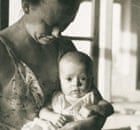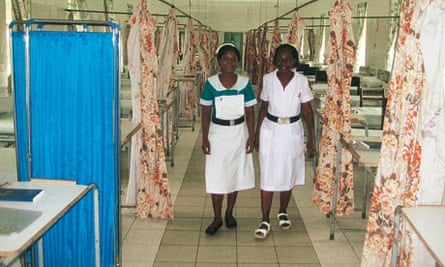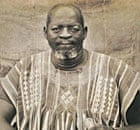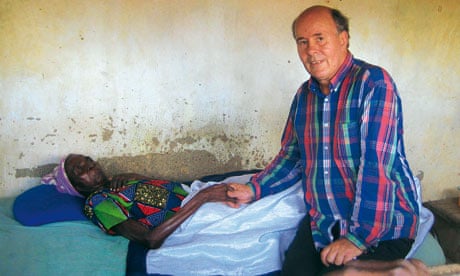Sometime in 1947 or 1948, King Jorbie Akodam Karbo I summoned one of his young unmarried daughters to the palace at Lawra. The all-powerful ruler of the small kingdom in the far north of what is today Ghana, but was then the Gold Coast, told the girl she must go to Accra, the capital of the colony. She was to learn to be a midwife and return to teach others, so helping to prevent the many childbirth deaths that were taking place in the community.
You can imagine her trepidation at leaving. The journey of around 600 miles south would have taken many days in the weekly post bus. The girl knew no one, none of her family had ever been to a city or seen the sea, and she would have barely seen a car, let alone a white person. She stayed in a boarding house and learned to nurse at the colony's principal hospital, Korle Bu.
At around the same time, another young woman, my mother, set off on what was to be an equally adventurous journey, from Liverpool to Accra by boat. My father was to be the last in a long line of West African colonial administrators, and, like the princess, Mum knew no one in Accra. She had barely met a black person, and knew only that the Gold Coast was a dangerous place because of malaria and other tropical illnesses.

The two women struck up a friendship in January 1949 after my mother, remarkably for the time, chose to give birth not in Accra's private European hospital but at Korle Bu, the public African hospital. Mum never told me the name of her midwife, but used to say I had been born with the help of the "beautiful daughter of the King of Lawra", who "had her teeth filed to sharp points that made me think she was a cannibal". Having me at Korle Bu, she said, was not just an act of faith in the new Africa then emerging with powerful independence movements after the second world war, but also a pragmatic decision. "You got a better standard of care there!" she would say.
The women never met again. Within a few years, we had moved to Nigeria and the King of Lawra's daughter had left Accra.
With the world's population officially hitting 7 billion this week, just 12 years after reaching 6 billion, I went back to Accra to try to understand the massive explosion in human numbers that has been largely responsible for Ghana's development since I was born, and that will, for good or else, determine its future. In those 60 years, the world's population has grown by two new Chinas and an India combined; Ghana has doubled and doubled again from around 4 million people to more than 25 million. It is projected to keep growing to around 50 or even 60 million people by 2050.
How will this small country, which is seen as one of the economic and social success stories of Africa but which is in most parts still desperately poor, cope with twice as many people in just over a generation? Clutching a birth certificate, some old black and white photos of the houses we lived in, a description of the princess with filed teeth who delivered me, and a tourist map, my plan was to find my midwife's family and to trace the roots of Ghana's population explosion through the places that we knew.
Clearly, the city to which the two women travelled in the late 1940s is unrecognisable today. Accra was then about the size of Stoke or Shrewsbury. Now it sprawls 30 or more miles from the old town centre, throwing up new slums and suburbs every year. A 1948 census estimated 4,113,345 people and 3,035,125 goats in the whole country. There were fewer than 2,500 Europeans and only 84 doctors, of whom just 17 were Gold Coast Africans.
What hits you hardest, though, is not Accra's size today but the fact that everyone is young. It is rare to meet anyone over 40. Officially, 3% of Ghana's population is over 60, but these are mostly invisible people. In fact, more than one in three people are under 14, and the country is adding nearly 500,000 children a year.
My questions started at Korle Bu hospital, in 1949 a collection of quite grand, collonaded buildings, these days Ghana's premier teaching hopsital. My old maternity ward is still there, now sponsored by Latex Foam, but most births take place in a purpose-built six-storey baby factory built in the 1960s. A young Accravian mother-to-be now has a choice of giving birth in nearly 20 private and public hospitals and clinics in the city. If the family has $5,000, she can stay in what is effectively a five-star hotel. If poor, as the vast majority are, she may have to share a bed or sleep on the floor at Korle Bu. Every day 35 babies are born there.
"That's 12,000 babies a year from this one hospital," says Professor Samuel Obed, head of obstetrics and gynaecology, who says that Ghana's population explosion has been a triumph of modern midwifery, prenatal and maternal care. He puts the success down partly to people such as the young princess of Lawra who learned so well how to deliver babies and teach others. "The vast increase in the number of people in Ghana today is entirely due to the efforts made to stop birth mortalities. I put it down to better education. As more people get a formal education, so they see the need to have proper prenatal care. Many women in the past never went for prenatal care. Now 95% in Ghana do. Back in 1949, it was only available to a very few people.

"In your mothers's time here, everything was still left to nature. People used to offer a libation or they would pray when they gave birth. You lived or you died in childbirth. It was very risky. A lot of people died. That is why in Ghana new mothers wear white. Birth is seen as a victory.
"Your nurse probably came here at a very young age. She would have been one of the first generation of northerners to have a formal education."
The population explosion puts immense strains on the health service, he says, with nearly half the hospital's resources being spent on childbirth and the rest on illnesses related to malaria. "Everything comes down to money. We need to re-equip one operating theatre to take care of caesarean births. We need more nurses... The explosion in numbers is not going to go away. Women are having fewer children, but they are surviving and there are more and more families. It's cultural. If a couple have no children, you will have the in-laws round their necks. Pressure to have children is not going to abate."
"Everyone used to have big families in your mother's day," says Felicia Darkwah, a retired teacher born in 1926 and typical of the wealthy, land-owning, educated Ghanaians who took over from the British at independence in 1957.
I met her in the sitting room of 47 Seventh Avenue, the first house we lived in in Accra. Most of the other houses in the street have since been pulled down and rebuilt as embassies, banks or private executive residences. They hide behind high walls and razor wire, are guarded night and day, and can cost as much as anything in Chelsea, London. But number 47 is almost unique. Still owned by the government, its grounds have been divided up for three other houses, but it has barely changed. The rosewood parquet floors are the same but now lifting, the ceiling fans have rusted a bit and been augmented by air conditioning, but the pre-independence bungalow with its tin roof is intact, lived in for the past 24 years by Felicia, her Cambridge-educated agronomist husband and two of their children and their families. (One is now a very high-ranking government official who is fearful of being identified.)
"I am one of 13 children," Felicia says. "That was a small family for the time. My uncle's daughter, Animeh, died the other day and she had 100 children and grandchildren. I've known people with far more."
There seems to be a rule of thumb among educated Ghanaians that each generation has about half the number of children as their parents. Felicia had five children, and her children have two or three each. "I don't think anyone needs to bother about the numbers in Ghana as long as we work hard," she says. "We can produce enough food but the speed of growth is difficult."
I show her the pictures of my father's office, a young white man surrounded by more than 50 Africans. "This face looks familiar… and that one," she says.
Next week the UN will warn that the world population could spiral not to 8 billion or 9 billion people as demographers expected in the 1980s, but to 10 billion, or even 16 billion after 2100 if countries do not control their populations soon. And while it will be the rich whose consumption of goods is likely to destabilise the climate and global food supplies, it will be the very poorest countries of Asia and Africa that will be left to cope with inevitable large-scale environmental degradation, the explosion of slums, pressure on health and education services, and the reality of living in a world without enough food and water for all.
Of all the continents, Africa will see the greatest changes in the next 40 years – 11 countries in the world have fertility rates above six babies per woman and nine of them are there. Sub-Saharan Africa's population was around 100 million in 1900, 750 million in 2005 and the latest UN projections suggest it will level off at over 2 billion after 2050.
West Africa will be at the centre of this tidal wave of births. Nearby Nigeria, now with 150 million people, is expected to have 600-725 million before numbers start to tail off in 40 years. And far from reducing fertility rates, some countries', such as Mali's, are still rising.
Space is not the problem for Ghana or most other African countries. The continent is physically big enough to fit China, India and the US in its boundaries, and it can grow enough food for itself and for others. But a rapid, huge population increase linked to deep poverty in ecologically fragile, nearly landlocked countries such as Chad, Niger, Ethiopia and Mali terrifies planners and demographers the world over.
In Niger, a few hundred miles east of Ghana, two in three people are under 20, women have an average of more than seven children and only 5% of adults use any form of contraception. If its current growth rate of 3.3% per year remains unchanged, by 2050 it will have 56 million inhabitants, from under 15 million today. It is already one of the poorest countries in the world, it is intensely vulnerable to climate change and is experiencing regular food crises.
Other west African countries, such as Burkina Faso, traditionally saw their youths migrating to other countries to relieve pressure on environments, but Ghana, growing at less than 2% a year, is much better off, says Marilyn Aniwa, head of the Union for African Population Studies: "Hunger will not be the problem here. Contraception is still not widely used, but the country has land, water and space enough to double in numbers.
"But population is not about the numbers of children. It's about environment, rapid urbanisation, wellbeing and human rights. These are the areas that have not been addressed in the same way as midwifery and prenatal care. Development has not kept up with the numbers. What has been left behind is the social aspects."
You can't just pin all the problems on African governments, say demographers. Back in the 1970s, family planning was high on their and western political agendas, but in the 1980s countries such as Ghana were treated by the IMF and Britain as laboratories for enforced economic reforms and debt programmes. Contraception and family-planning programmes, just beginning to have an effect, were sidelined. The free market economy pushed on Africa may have worked for the cocoa farm and gold field owners of Ghana, but there was far less money for health and education. The result was a rapidly growing, ill-educated, fast-breeding generation living in a technically richer but more unequal country where people knew how to save children dying at childbirth but were not able to look after their long-term interests.
"The danger is that we now revert to how we were 30 or 40 years ago," says Emmanuel Ekaub, a Cameroonian demographer. "Maternal mortality is worsening across Africa again. Poverty is worsening again, and the cities and planners cannot cope."
Five minutes down the road from 47 Seventh Avenue is 9 Second Circular Road, a brutish two-storey house built by the colonial government in 1950 for my father and his young family. In those days it was exclusively for elites. Nothing changes. Now the road is reserved, it seems, for diplomats, judges, bankers, government ministers and people with £300,000 to spend on an apartment.
But number 9 stands empty behind a concrete wall. A large tree has grown right outside the front door, the gardens, laid out in the English cottage style of the 1950s, are overgrown, and a high court judge and his daughter live in what were the servants' quarters to the side.
Number 9 is still owned by the government but it hides a dark secret. No one wants to live there when they hear that, in 1982, it was the scene of Ghana's most notorious political murder. A military junta, led by Flight Lieutenant Jerry Rawlings, had seized power months earlier and there was a curfew in place, but on the evening of 30 June a death squad called on Cecilia Koranteng-Addo, a high court judge who was living here and, at the time, breastfeeding her baby. She was abducted, along with three others, and their bodies were later found riddled with bullets. The "enemies of the revolution", as Rawlings called them, were never caught.
In fact, number 9 is squatted. Two lads, who call themselves D.Jen and D.Beal from "X-tribe", have stuck their pictures to the wall of the old living room. "Fuck U Mother Fucker" someone has scrawled. There are cigarette butts, bottles of cheap South African wine, and a bedroll and TV in the old cloakroom.
"What Ghana's population explosion has done is suck young people into the city," says Aniwa. "They live in kiosks, old shipping containers, anywhere they can find. Some live in incomplete houses. New suburbs and townships like Gbawe, Sowutum amd Ashiaman are sprouting."
"Urbanisation will inevitably go to another level in the next 20 or 30 years," says Delali Badasi, a researcher at the Regional Institute for Population Studies at Accra University. "The average young person does not want to live in rural areas. They are all leaving to come to the cities. The slums will increase. We can't even house people today. The problem is the speed of change."
Opinions are sharply divided among economists about the advantage of having a younger population and youthful workforce. According to the government, 250,000 young women and men enter the job market every year, but the formal sector is able to employ fewer than 5,000 of them. "A rising population will support local firms and inspire foreign investment, but unless the youth have jobs and social betterment is achieved, the risk of social uprising is profound," says Simon Freemantle, Standard Bank Africa's senior analyst. "There is a real risk of social instability if the disgruntled youth feel left out."
We had sent a message north to tell King Puowele Karbo III in Lawra that we were trying to track down the family of the young princess who had delivered a white baby back in 1949. But that had been several weeks ago and we had received no reply. So, with a long journey ahead, warnings of bandits and no idea of what would greet us at the other end, we, too, set off in some trepidation.
It takes at least two days to reach Lawra from Accra. We flew 400 miles to Tamale, found an old banger and a driver, and travelled the last 200 miles along some of the worst roads in Africa, passing the great Bole national park with its elephants and baboons, villages with names such as Tuna and Ya, and shops called The Forgive And Forget Chemical Drug Store. The land is mostly flat and, this being the end of the rainy season, quite green.

Late in the evening we presented ourselves at the palace, a rambling collection of low buildings, some built underground, a courtyard dominated by two enormous marble graves and several flagpoles. We were greeted by the king's brother, who said he knew we were coming because our car made an unusual sound. We arranged to meet the family the next day.
When you have an audience with King Karbo, you must bring libations, in this case two bottles of gin. He greeted us from his throne, animal skins strewn at his feet and pictures of his ancestors on the walls. "We believe that we have identified the woman your mother knew," he said. "She was one of the first ladies from the north of Ghana to be sent to Accra for training. My father believed we needed a trained midwife because so many children were dying under the traditional childbirth system. It was a very important mission. The whole community depended on her."
The concept of children in a place such as Lawra 60 years ago was pretty relaxed. They defined men's social standing, they were needed to increase wealth, they were assets to work the fields and fetch water, but numbers did not matter. A man did not look after them, and no one actually knew how big families were.
In retrospect, it would seem that King Karbo I, Puowele's father, was on a mission to populate Ghana singlehandedly. When he died in 1967, the family tried to count his offspring. "I did a population census of him in 1970," says the king. "We counted about 70 daughters and 35 sons. He left 39 widows. I could not count them all. Our children are many, and traditionally we don't count them. We don't actually know how many he had – he never counted them. He tried keeping records, but it didn't work."
Today, says Puowele, children are no longer seen as an asset. He has eight, his brother, an international athlete and recently retired university lecturer, five. "The trend is downwards. Nowadays the demands [on families] are great. You are in deep shit if you have too many. So you go for quality rather than numbers."
If his father had been responsible for so many births, and his relative had devoted her life to saving children as a midwife, Puowele could be said to have played a major role in Accra's rise from a small town to a megalopolis. He was national director of planning in the city, and devoted a lifetime to trying to control the tide of young people heading to the cities from places such as Lawra.
"Yes, Accra is a mess," he concedes. "We just could not control the population. We created a green belt, we planned reservoirs to stop flooding, we planned for oil, but the [politicians] refused to implement these things." He and his colleagues even considered building a new capital city to take pressure off Accra. "We looked at Abuja, the purpose-built capital of Nigeria. You can build a city from scratch, but if you do not change behaviour, it will be the same as the old one."
Lawra survived by traditionally exporting its youths to Accra and the south, to the gold mines and coffee plantations. "Women here still have eight to 10 children, but these days they are living. We are the stubborn ones, who refused to die."
Even so, Lawra is testament to what happens if people overuse resources and approach their ecological limits as is happening across large parts of west Africa. "Our environment has suffered badly from the pressure of numbers," the king says. "Our natural resources are diminishing. Our forests are being cut down. We can no longer find the herbs we used to use. The river bed is now silting up because we are farming close to the banks of the river. There used to be a gap between the villages, but now they are joining up. We cannot capture rainfall in the increasingly long, dry spells. Climate change is taking place."
But Lawra's future, he says, is not bleak at all. Like most Ghanaians, he loves children and believes that, if planned better and given a fair wind, the country's burgeoning population will be the key to its future prosperity. "We will have to diversify, yes. We will learn new things. But we are still confident in the future. Lawra will become a city, with all its social problems."
He turns the conversation back to the princess. "I can tell you she is our auntie. Your mother was very observant to see she had chiselled teeth. Her name is Stella Yeru, or Mrs Kuortibo. She had four children, two of whom are living now. The boy is a tax inspector at Tamale. She filled a void. She paid her dues. She worked in Lawra and all the other big hospitals in the region. She would have trained very many people. It was very rare in those days for a woman to work in public service like her. We can think of no other women like her. She was a pioneer. If you worked under her, you had no place if you were lazy."
Out of the blue, the king then asked if I would like to meet her. I was flabbergasted. Stella must now be in her mid-80s and I had not expected her still to be alive, let alone there. "But she is very old. She is bedridden and has forgotten everything," he warned.
We find a very frail old lady lying in her bed on the veranda of the house she had had built just outside the palace walls. She was beautifully, even ceremonially dressed, but was very weak and clearly near the end of her life. Her son, Anthony, had come to be with her.
I held her hand as her helper told her that I had come from London because she had delivered me at Korle Bu hospital in Accra all those years ago.
"Yes, I remember the white woman," she said in a thin voice that spoke loudly across the generations.

Comments (…)
Sign in or create your Guardian account to join the discussion